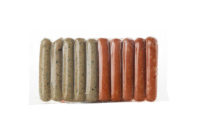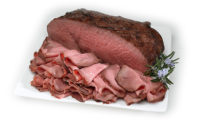Post-packaging pasteurization offers a multitude of benefits for processors in the meat and poultry industry. The primary reason that post-packaging pasteurization has been used in the meat industry is to eliminate Listeria monocytogenes from the surface of ready-to-eat meat products, which have been exposed to the environment between the cooking and packaging processes, i.e., post-lethality contamination, says Lynn Knipe, an extension processed meats specialist and associate professor in the Department of Food Science and Technology at Ohio State University in Columbus.
Exposure refers to removing the casing or packaging film from a product after cooking, but before packaging. For some products, such as turkey breasts, post-packaging pasteurization might allow for processors to produce a safe ready-to-eat product, without adding nitrites, lactates, diacetates or other antimicrobial agents to the product, resulting in a cleaner labeled product, Knipe explains.
Post-package pasteurization is beneficial to West Liberty Foods (WLF), West Liberty, Iowa, because it improves food safety, extends the shelf life of products and allows for clean-label formulation, says Joe Swanson WLF’s vice president of operations.
“WLF utilizes high-pressure pasteurization (HPP) for its post-packaging pasteurization,” he explains. “HPP provides desired product improvements without affecting the sensory properties of the product. Additionally, HPP can be utilized without making any changes to the pre-packaging production processes.”
Bridgewater, N.J.-based Applegate, a subsidiary of Hormel Foods Corp., produces what it calls “clean, craveable” food, and uses primarily HPP for post-packaging pasteurization with its ready-to-eat, refrigerated foods because it allows the brand to deliver on that promise, says Nicole Glenn, Applegate Farms’ vice president of marketing.
“HPP gives us the best tool to preserve the freshness of our deli meat, bacon, hot dogs and other items without using additives or affecting the taste, texture or nutritional value,” she explains.
Applegate primarily uses HPP for its ready-to-eat, refrigerated foods as they pose the greatest risk for pathogens. “We have very specific time and pressure requirements for all of our products that go through HPP, including restricting the time that a product can reside in its package prior to going through HPP,” Glenn explains.
Applegate also believes in creating great-tasting products that use simple ingredients that people can recognize and have in their own kitchens. “Transparency is a core value for Applegate, and HPP allows Applegate to provide simplicity and transparency in labeling, while also ensuring a superior level of food safety,” Glenn says.
In addition, product labeling can now contain information on the method of post-packaging pasteurization that was used, which helps the consumer make informed decisions on their product purchases, WLF’s Swanson says. Labels can be designed to visualize to the consumer that a post-packaging pasteurization step has occurred, he adds.
Additionally, several steam and water bath methods for heating meat products in a package are available for processors to use, and reheating the surface of fully cooked products in hot water tanks may be the most popular today, Knipe says.
“A process, which may be even more popular today, is the process of heating partially cooked sausage links in their final retail package, which prevents environmental contamination of the sausage links until the package is opened by the final consumer,” he explains. “This is done primarily by co-extruding coarse ground sausage links before placing them into the retail package. However, this can also be done with natural casing sausage, which has been smoked and partially cooked in a smokehouse, just to the point that the links can be separated and placed into the retail package, and then cooked in steam or hot water.”
Another category of products that have been around for a long time, but still fit this category, are products that are either stuffed into moisture-impermeable casings or cook-in bags or pouches, cooked in water and distributed to the end users without removing the casing or cook-in bag.
“I see this increasing, particularly for ham and other whole-muscle deli products that are intended to be sliced at retail,” Knipe says.
Future of post-packaging pasteurization
While the number of HPP processors in the industry has grown exponentially during the past decade, it is still a relatively novel technology, which can make cost an issue, Applegate’s Glenn says. “Using HPP also can present some challenges with including value-adds to packaging like immediate redemption coupons,” she adds.
One challenge for WLF with HPP involves the production of raw products. “The HPP process causes color changes with raw products that are undesirable to the consumer,” Swanson says.
The major challenge processors have experienced with post-packaging pasteurization of sausage is the impact the heating process has on the product appearance, Knipe says. “Product formulas typically need to be adjusted to minimize moisture loss and fatting out of products that are cooked in their package,” he explains. “What happens in the package stays in the package for consumers to see.”
The meat industry’s focus up to now, with post-packaging pasteurization, has been the elimination of Listeria on the surfaces of refrigerated, ready-to-eat meat products. But the revised Appendix A that the U.S. Department of Agriculture’s Food Safety and Inspection Service (FSIS) has recently released suggests that some issues with post-lethality contamination of Salmonella exist, Knipe says. “I wouldn’t expect Salmonella to survive and grow at refrigerated temperatures like Listeria will, but Salmonella is on FSIS’ radar, so this may change the type of products which require post-packaging pasteurization, such as shelf-stable products that do not require refrigeration,” he explains.
Moving forward, Applegate’s research and development team thinks the other benefits of HPP, such as tenderization, color stability and replicating the aging process in some raw material, have begun to emerge. That being the case, Glenn thinks there are opportunities to use HPP beyond food safety and in the pursuit of developing great-tasting food.
WLF’s Swanson also believes the use of post-packaging pasteurization will continue to grow.
“Consumers are actively looking for clean-label products and will not compromise on food safety,” he says. “Each food category will look for the post-packaging pasteurization method that achieves the desired result in a cost-effective manner.” NP





Report Abusive Comment